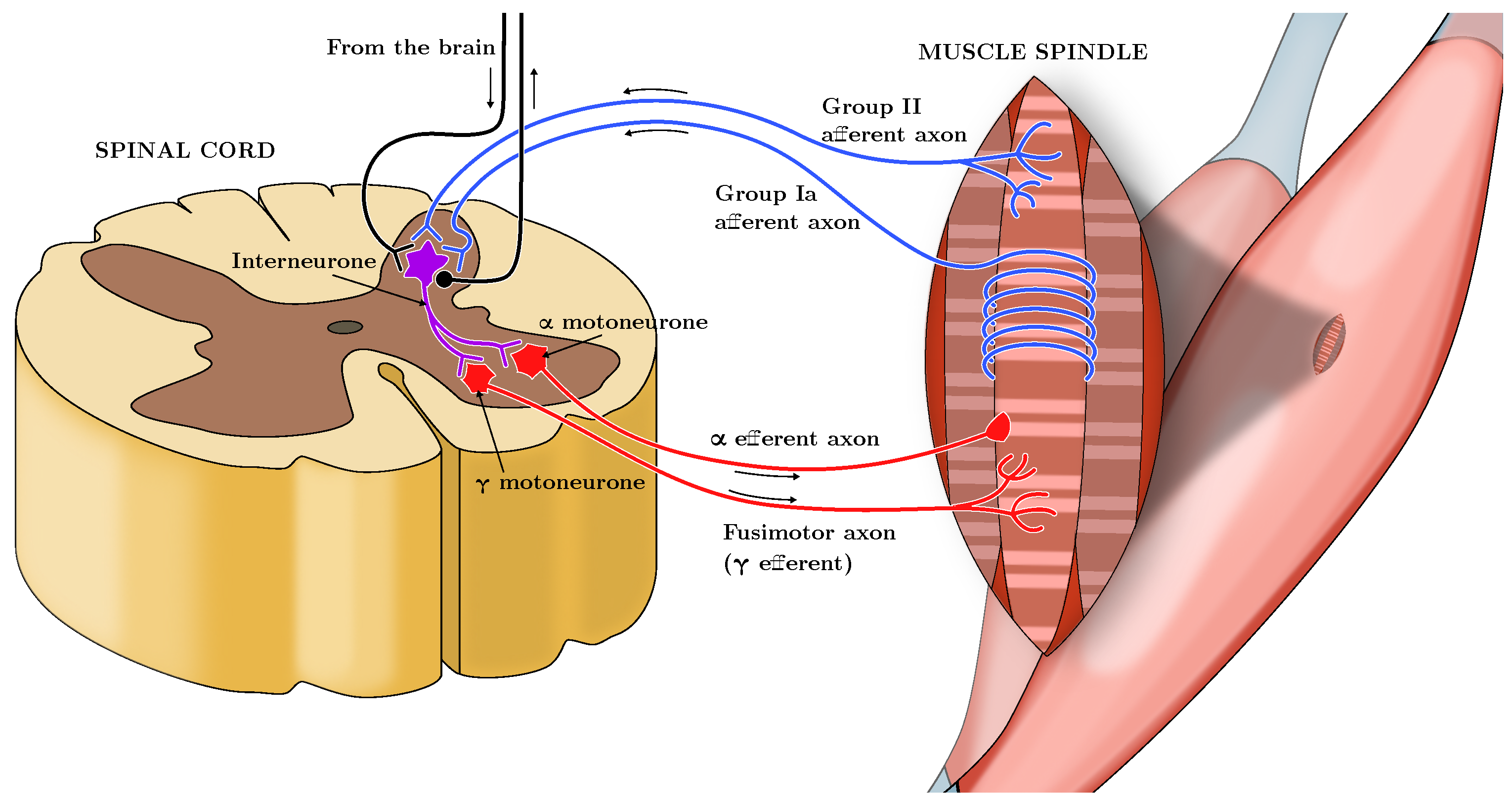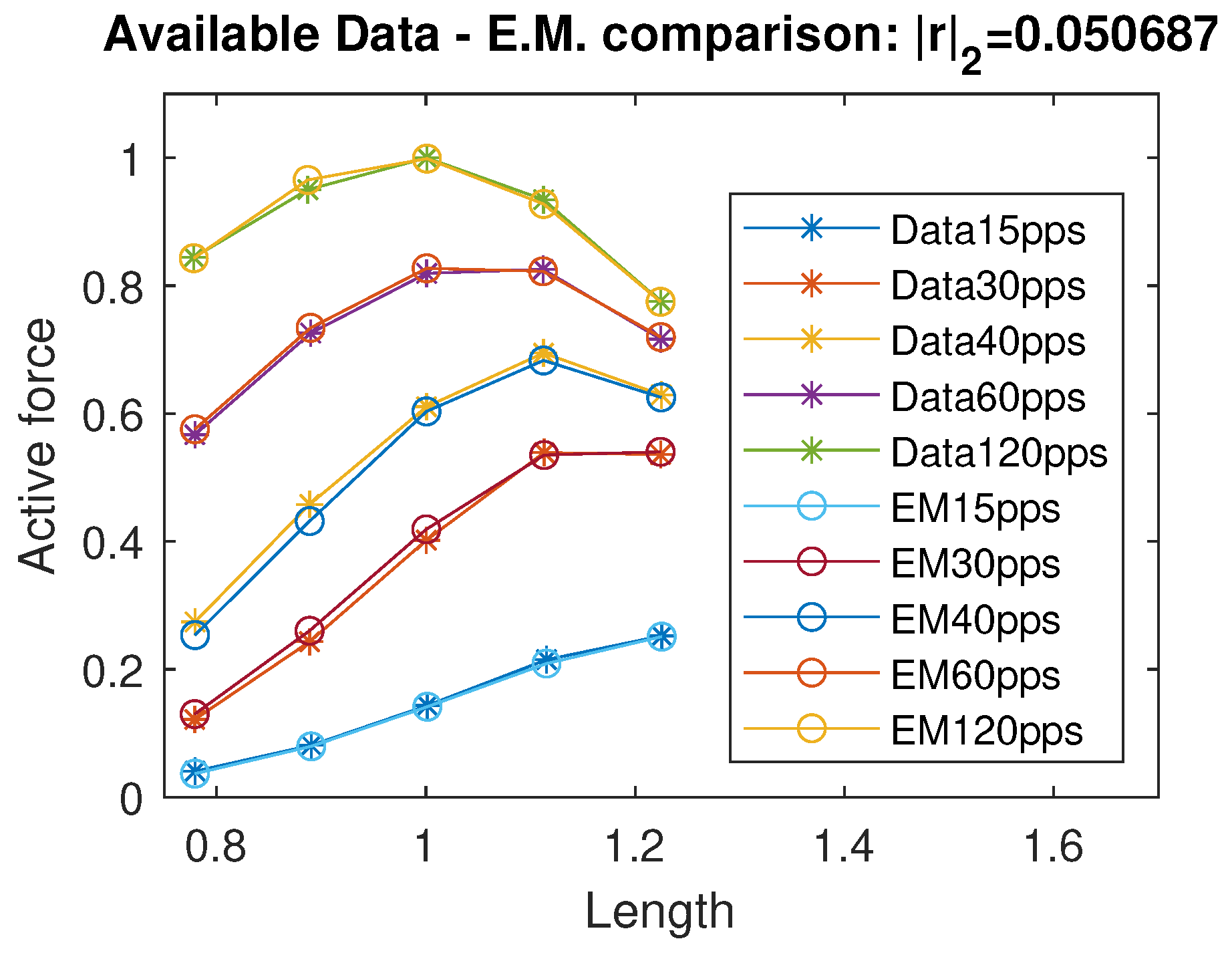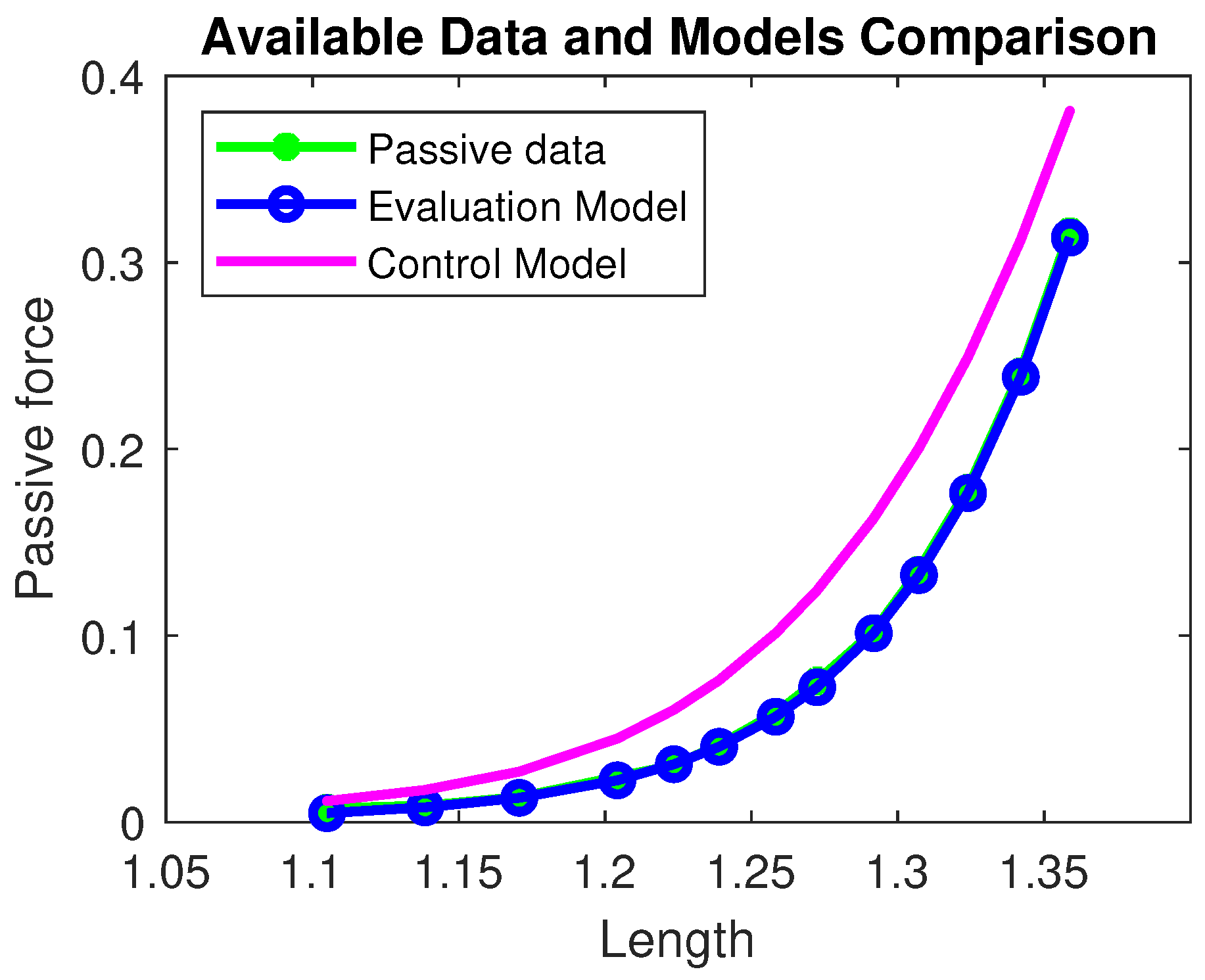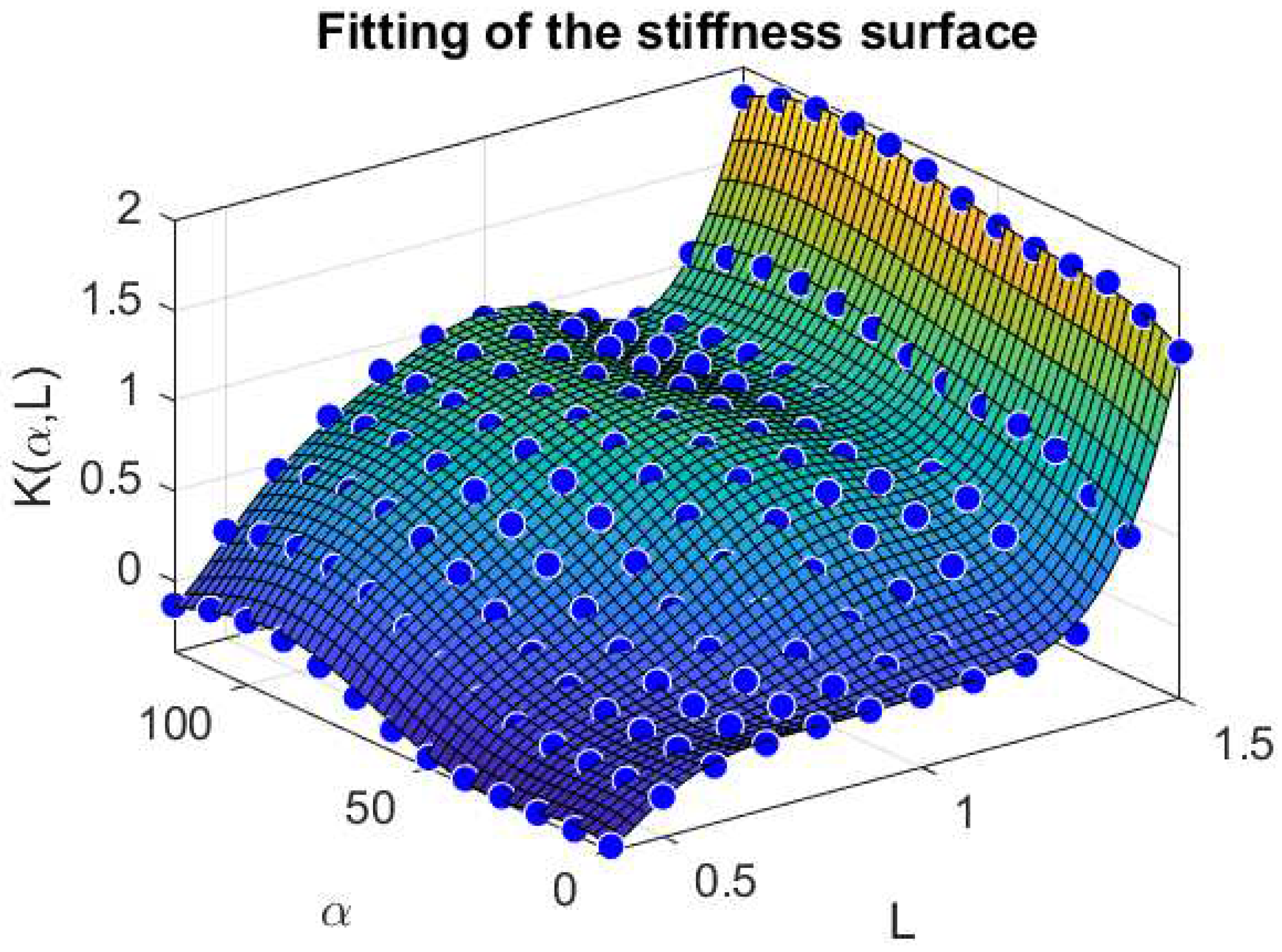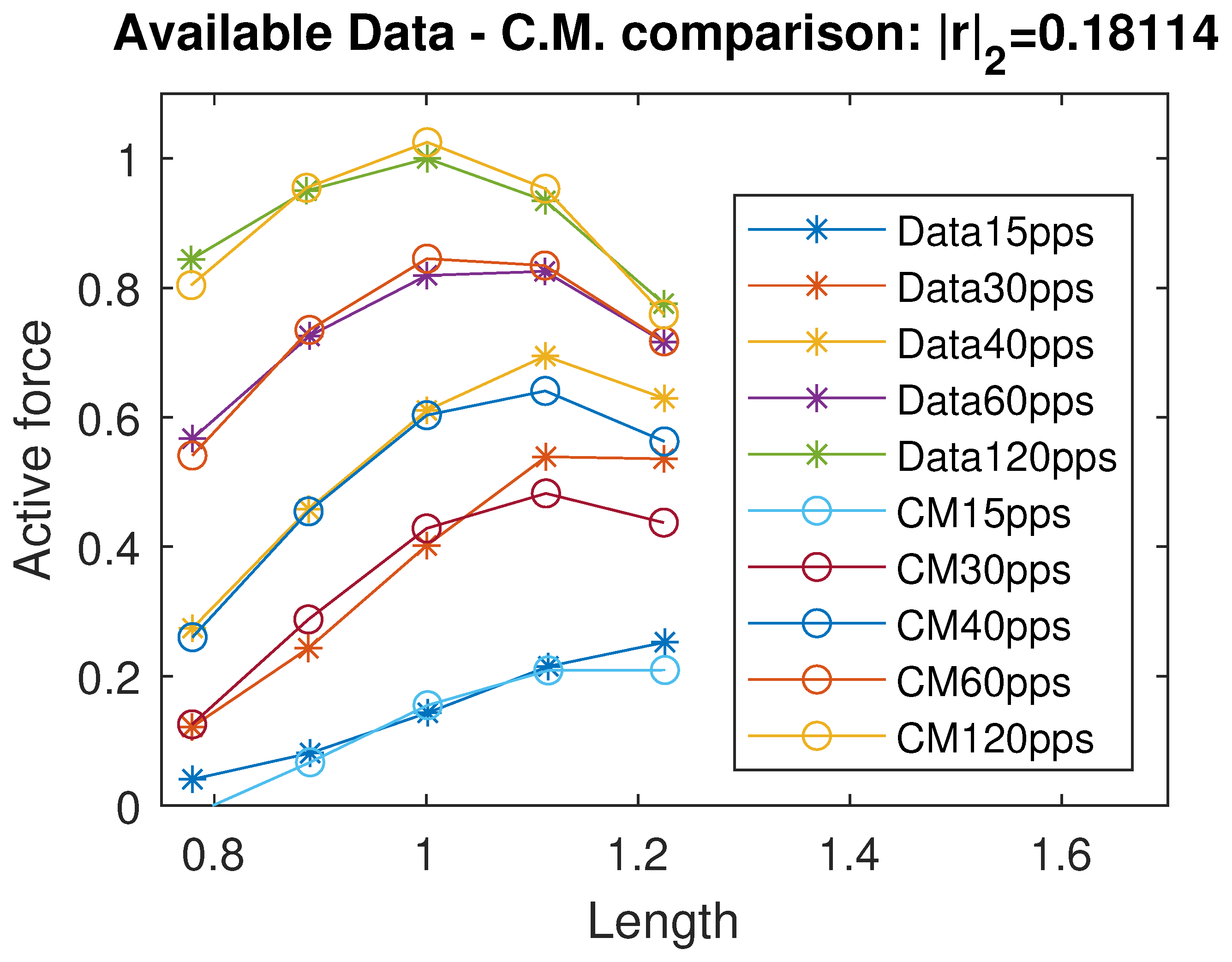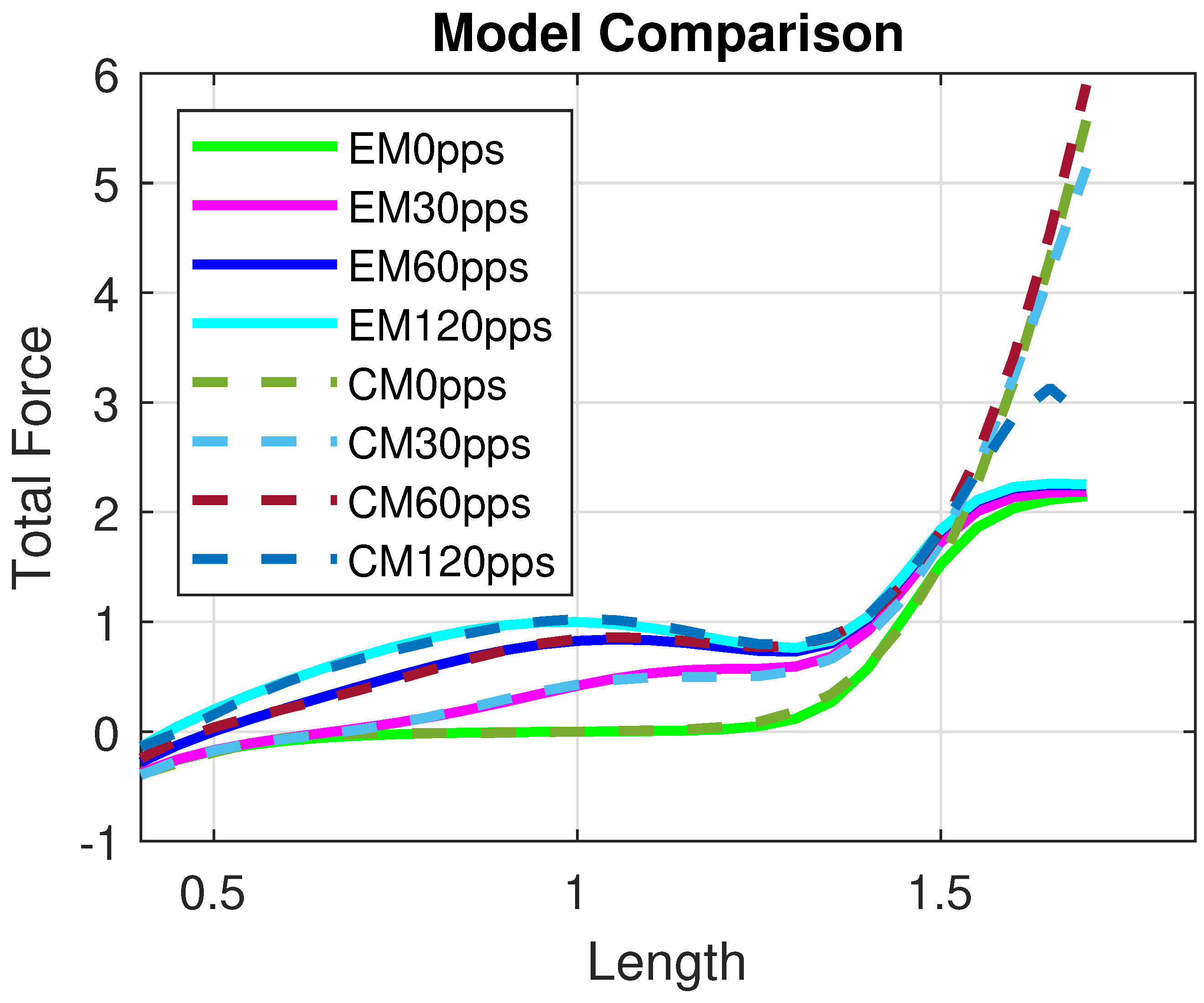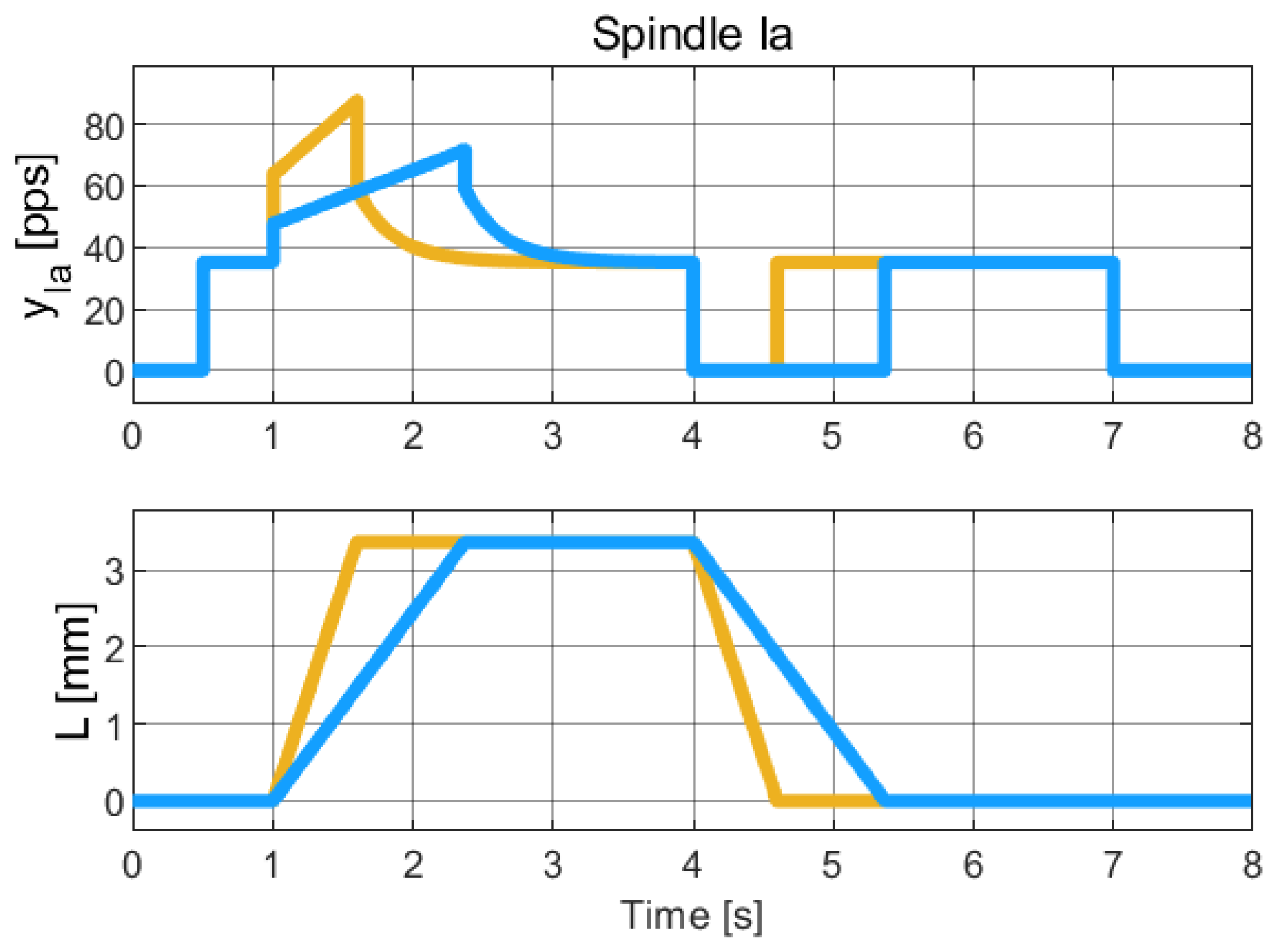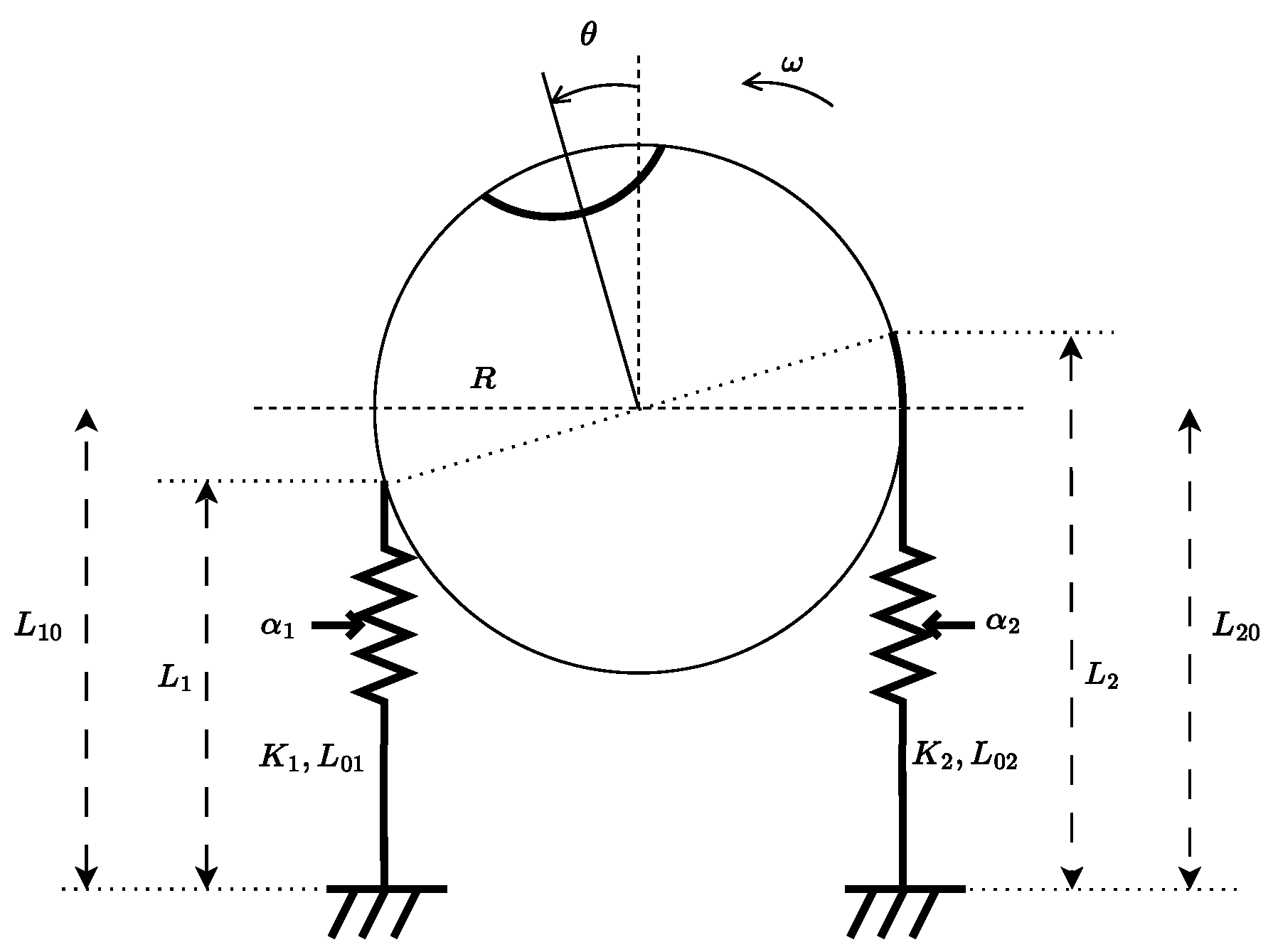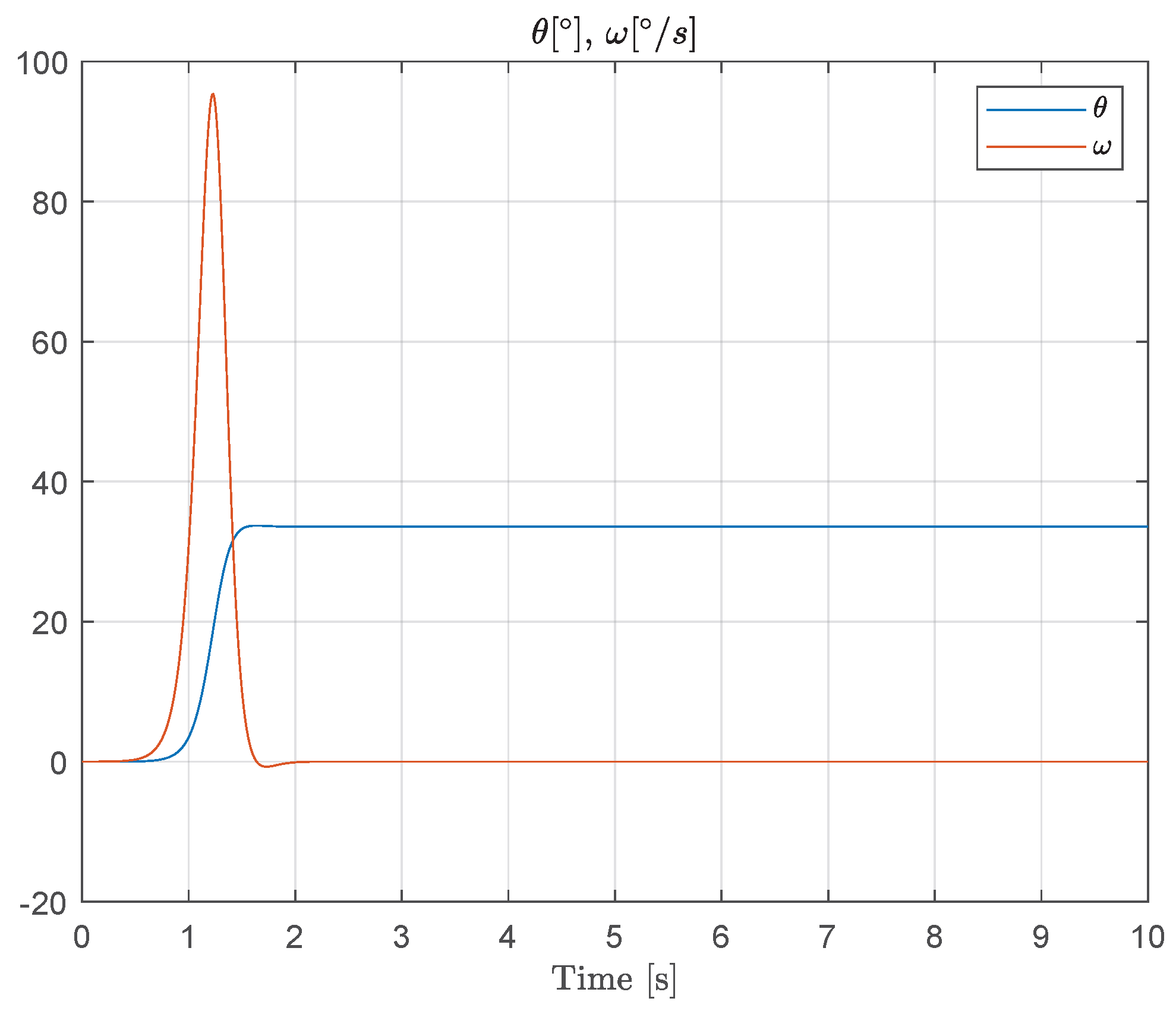1. Introduction
Skeletal muscles, or simply muscles, are organs of the muscular system whose cells have the ability to generate force and movement in response to electrical stimulation. They are primarily attached to the bones of the skeleton via tendons and, because of their contractile and elastic properties, enable the relative motion of bones at the joints they actuate.
Each skeletal muscle consists of thousands of muscle fibers bundled together and enclosed by connective tissue sheaths (see, e.g., [
1], Chap. 9). These bundles of muscle fibers are called fasciculi. Each muscle fiber contains numerous myofibrils, which in turn are made up of repeating units of myofilaments. When assembled, these myofibrils exhibit a characteristic striated pattern, forming sarcomeres, the fundamental contractile units of skeletal muscle. The two primary types of myofilaments are actin (thin) and myosin (thick), which are arranged in a regular pattern that gives rise to the distinct banding appearance of skeletal muscle [
2,
3,
4] (Chap. 1).
Skeletal muscles appear with neuronal innervations of the sensory-motor system. A set of neurons, i.e., the
-motoneurons, constitutes the neuromuscular junction. They are responsible, through their excitation frequency (Here labeled as
, measured in pulses per second, or pps), for the sarcomeres contractions, and hence they allow the generation of the active force of the muscle. On the other hand, another set of neurons, which constitute proprioceptive receptors, carries sensorial information from the muscle to the Central Nervous System. In particular, transmitted signals are the values of muscle length and rate of change (Spindles-Ia and -II) and the measurement of the force value at the tendon level (Spindle-Ib or Golgi Tendon Organs (GTO)). We can see the muscle structure from a system-theoretic standpoint as a multi-input multi-output system with the actuator (
-motoneurons), the plant (the muscle cells, whose contraction produces the exerted force on the joint), and the sensors (Spindles -Ia and -II, and GTO), and the CNS as a feedback controller. A schematic of the neurological connections involved is depicted in
Figure 1, inspired by [
5].
The modeling of how muscles exert force started with the work of [
6], in which muscle description is presented through a spring-like behavior. In particular, the relationship takes into account a contractile element that produces muscle force and it is put in series to a passive elastic element representing the tendon model between the muscle fibers and the connected bones or tissues. This model has then been exploited to generate more detailed models [
7,
8] in which the authors describe the microscopic behavior of contraction behavior generated by the effects of sarcomeres and cross-bridges. In [
9], Hill’s model has been enriched with a ‘damping element’. In [
10,
11,
12], experimental data have been used to construct an analytic expression of the total force generated by muscles. In these works, the total force has been divided into a length-dependent component
and a velocity-dependent component
, both modulated by the excitation frequency of the
-motoneuron. The
term is further decomposed, in line with Hill’s model, into an active and a passive component. The active force accounts for the contraction generated by muscle fiber activation and is responsible for movement, while the passive force reflects the intrinsic elastic response of muscle fibers in the absence of activation. A fundamental reference in this context is the work of Zajac [
13], which provides a comprehensive overview of muscle and tendon dynamics and has laid the groundwork for many modern neuromechanical models. Experimental data and force generation models are available for isometric (fixed muscle length) and isokinetic (fixed muscle velocity) configurations and have been discussed in [
10,
11,
12,
14,
15].
In [
9,
16,
17], a system-theoretic perspective on the neuromuscular system has been proposed, where the authors provide a control-oriented interpretation of the various physiological components involved. In [
18], the focus is instead on the optimal co-activation problem, with the aim of minimizing the mechanical impedance of a biological joint actuated by antagonistic muscles (e.g., the elbow).
In recent years, the contractile properties of the neuromuscular system, particularly those involving Hill’s model equations, have been further investigated in [
19]. In [
20], an analytical model of complete and incomplete tetanic contraction has been proposed which, to the author’s knowledge, represents the most realistic dynamical model of muscle behavior currently available.
The sensory components of the muscle system are responsible for measuring plant variables such as tendon force (through the Golgi Tendon Organs, GTOs) and muscle fiber length and its rate of change (through Spindles Ia and II). These elements have been extensively studied in [
5,
21], and a comprehensive review of related works is provided in [
22]. For a more recent overview, see [
23].
From a systems engineering perspective, a dynamical model of GTO behavior has been presented in [
24], which introduces a transfer function that maps the tendon force to the firing frequency of GTO neurons. For Spindles Ia and II, a static model was proposed in [
25] to describe the relationship between fiber length, its rate of change (velocity), and the excitation from
-motoneurons to the spindle firing rate. These
-motoneurons are responsible for modulating the response of the associated spindle system. The sensory system plays a crucial role in the architecture of movement control. In particular, the presence of internal loops between the muscles and the spinal cord enables the activation of reflexes such as the stretch reflex, reciprocal inhibition, and others [
17,
26,
27]. A key component of this architecture is the spinal cord, which connects the Central Nervous System (CNS) to the
-motoneurons via interneurons. It is inevitably involved in motor control processes [
28,
29,
30].
The paper is organized as follows. We conclude this Introduction by providing the main motivations for the study. In
Section 2, we discuss some considerations regarding the available experimental data.
Section 3 presents the muscle models found in the literature, which have been derived on the basis of these data. In
Section 4, we introduce the models developed for isometric muscle force.
Section 5 is devoted to the hybrid modeling of the sensory system embedded in skeletal muscles. An application of the proposed modeling framework to the oculomotor system is presented in
Section 6, along with a discussion of the related challenges. Finally,
Section 7 concludes the paper by summarizing the main contributions and describing the directions for future research.
Motivations
This work aims to describe neuromuscular behavior within a control-theoretic framework. In particular, we seek to gain a deeper understanding of the role of neuromuscular feedback loops and how they are exploited to control the movements of the limb. For example, in [
31], Iqbal et al. show the application of a stabilizing PID controller to a single-link biomechanical model, while Kistemaker et al. illustrate how sensory feedback can be used effectively in position and movement control [
32]. For insights into how waveform signals can be used to control delayed closed-loop systems, mimicking the spiking behavior of biological neural systems, see [
19]. We believe that adopting this modeling perspective provides a promising starting point for gaining deeper insights into the roles of different brain regions involved in learning and controlling dexterous movements. For references on this broader neurological context, see [
33,
34,
35,
36,
37,
38]. This line of research could also support the modeling and simulation of pathological conditions affecting motor control, a long-term research goal.
To begin addressing this long-term objective, we discuss how the proposed nonlinear spring model may serve to capture altered muscle properties seen in pathological conditions, such as increased stiffness in spasticity or reduced passive force in muscle atrophy. Furthermore, we suggest that the hybrid spindle model could, with appropriate parameter tuning, reproduce abnormal stretch reflex behavior, for example, exaggerated reflex sensitivity in hyperreflexia. To improve the specificity of the analysis, future extensions of the model could include spinal interneuron circuits, which play a fundamental role in modulating reflex responses through inhibitory and excitatory pathways. Accurate modeling of these components may help distinguish whether abnormal motor behavior arises from changes in peripheral sensors (e.g., muscle spindles), central processing (e.g., interneuronal gain) or efferent pathways, thus offering a more precise understanding of the underlying pathophysiology. In addition to structural or neurological impairments, it is important to recognize that factors such as emotional state, fatigue, and muscle temperature can also significantly affect muscle behavior. These influences can alter both the stiffness parameters and the resting length of muscle fibers, leading to variability in force generation and reflex response. Therefore, incorporating such modulatory effects, possibly through time-varying or state-dependent parameters, may enhance the physiological realism and clinical applicability of the proposed models.
Although this study does not include clinical data, the structure of the models is designed to be extendable to such scenarios. In
Section 7, we outline how future work could incorporate clinical datasets to refine and validate the pathological relevance of these models. The mid-term goal is to develop a comprehensive understanding of how the brain organizes and controls human dexterous motion, with the aim of replicating such strategies in the design of advanced nonlinear control systems, such as the nonlinear output regulation problem addressed in [
39]. This study intersects with the concepts of inverse and forward models, as introduced in neuroscience in [
40,
41]. See also [
42] for further applications of these principles. An intermediate step in this process, in our view, involves improving our understanding of how these models are formed, trained, and updated in the brain and how they contribute to the overall control strategy.
2. Preliminaries on Available Experimental Data in the Literature
In the muscle force, we can distinguish three main components: a passive force
that is always present due to the natural behavior of tissues and depends only on muscle length; an active static (isometric) force
that depends solely on muscle contraction length
L; and an active dynamic force (eccentric and concentric)
which also depends on the rate of change of muscle contraction
. The last two components are active terms and depend on the activation frequency
of the
-motoneuron. The isometric force data available in the literature are mainly those shown in the figures of [
11,
12,
18], which are summarized in this section for ease of reference.
It is worth noting that these data cover the activation frequency only within the interval [0, 120] pps (pulses per second), as is the maximum excitation frequency that the -motoneuron can ‘apply’ to the muscle fiber. At pps, the active force (i.e., the total force excluding the passive and dynamic components) reaches a maximum value, denoted in the literature by the symbol . This maximum force corresponds to a specific muscle length (which is not the maximum length, but the length at which the force is reached at pps). Almost all available data and models in the literature are normalized with respect to these two values; therefore, force and length data are typically presented as and , respectively. Accordingly, we consider a normalized model based on these normalized quantities.
A crucial aspect in our model development is the presence of rest-length values in the force characteristic (that is, values of
L for which the exerted force is zero) that depend on the excitation frequency
(see [
18]). This leads us to introduce a rest length (here, by rest length, we mean the value of the muscle length for which, at a given excitation frequency, the exerted force is zero). function
(distinct from
) that depends solely on the excitation frequency
, which can be used to describe muscle contraction behavior. A significant challenge is that most of the data in the literature lack information on these rest-length values, which are essential for our model development and motivated the development of two models of muscle behavior, as described in the following sections. To address this, we adopt the technique introduced in [
11]. Specifically, they first proposed a model without rest length, based on Gaussian terms (also detailed in
Section 3), and then added a negative passive term to compensate for the absence of rest length data. This adjustment allows the rest length points to saturate the force at zero, as clearly shown in [
11].
In the next section, we provide an overview of two prominent models available in the literature.
4. Proposed Muscle Models
Our main objective is to describe the isometric force
as a nonlinear controlled spring with variable stiffness
K and rest length
, that is,
where
is the excitation frequency of the
-motoneuron, and
L is the normalized muscle length (with respect to
, the length corresponding to the optimal-maximal-muscle force at a given excitation frequency
).
To clarify, we provide precise definitions of rest length and optimal length:
The
rest length is defined as the muscle length
L at which, for a given excitation frequency
, the muscle generates no force, i.e.,
The
optimal length is defined as the muscle length
L at which the isometric force is maximized for the given excitation frequency
, that is,
To obtain this final model, we first designed an intermediate evaluation model based on Winters’ considerations. In particular, we exploited the negative passive term introduced in [
11] to determine the rest length values for different excitation frequencies. This step enables us to later construct and fit the parameters of the final control model (
7).
4.1. Evaluation Model
To build the intermediate evaluation model, we consider the isometric force as composed of active
and passive
components, as in [
11]:
Inspired by the modeling approach in [
12], we describe active force curves as Gaussian functions with mean value
, standard deviation
, and amplitude
A, all depending on the excitation frequency
, as shown in (
8). In this context, the mean value parameter
corresponds to the optimal muscle length
, the coefficient
A represents the maximal force generated at a given excitation frequency
, and the standard deviation
characterizes the width of the force–length relationship around the optimal length, reflecting the mechanical properties of the muscle at that activation level.
By running a curve fitting algorithm, we were able to fit the active isometric force with a very good approximation; specifically, the standard Euclidean norm of the residual vector is
, where
r represents the vector of differences between the available force data and the corresponding values predicted by the proposed model. In
Figure 2, we plot a comparison of the active force between the data from [
12] and the intermediate model estimation. The identified coefficients are reported in
Table 1. Using the data available in [
11] and their considerations on negative passive terms, we propose a unified continuous model of the passive force term, exploiting a sigmoidal and exponential function:
where the coefficient values
, for
, can be found in
Table 2.
The sigmoidal behavior in the passive term (see
Figure 3) does not have a direct correspondence with experimental data but provides a plausible description of the physical limit of any elastic material; that is, beyond the ‘boundary’ length value, the solicited fibers begin to break.
The total isometric force is then given by saturating all negative values at zero, expressed as
4.2. Control Model
Due to the high complexity of the intermediate/evaluation model (
10), and to make the force relationship more intuitive from a physical perspective, we used the intermediate model to extract the rest length points and corresponding equivalent stiffness values. These data were essential to fit the parameters of the rest length
and stiffness
functions in terms of
and
L, thus constructing the final (control) model. The isometric force is thus given by (
7), which we report again here for completeness:
where both
and
K are modeled as polynomial functions in
and
L:
where each
, for
, is itself a polynomial function in
L:
The corresponding coefficients for the rest length and stiffness functions are reported in
Table 3 and
Table 4, respectively.
We also report in
Figure 4 a comparison between the stiffness surface fitted
and the corresponding data points extracted from the Evaluation Model, for varying values of
and
L.
In
Figure 5, we show the comparison between the Control Model and the experimental data. The residual vector
r represents the difference between the model output and the available data.
The model provides a good approximation of the Evaluation Model and, consequently, of the experimental data, as shown in
Figure 5. Moreover, the Control Model offers a reliable reconstruction of the total isometric force within the range
, as illustrated in
Figure 6. In particular, the residual norm is relatively small, with
, especially for
.
Since muscle lengths beyond are generally outside the range of motion allowed by biological joints due to mechanical constraints, the proposed control model is well suited for applications involving standard physiological movements.
6. Application to the Oculomotor System
In this section, we apply the proposed muscle modeling framework to the oculomotor system. This application is motivated by the works [
44,
45,
46], in which the oculomotor system is described under the assumption that actuation is not generated by muscular torque, but is rather directly modeled as an acceleration input, see Equation
in [
46]. In our opinion, this assumption oversimplifies the problem, suggesting that a more comprehensive analysis is required when considering an adaptive control formulation of the system.
We propose that a more realistic model must account for the activation of skeletal muscles through the firing rates of
-motoneurons, denoted
,
. These activations generate muscle forces, which, in turn, produce a torque on the eyeball. According to the labeling in
Figure 9, the horizontal motion of the eyeball is modeled as:
where
is the angular displacement with respect to the sagittal plane,
is its time derivative,
J is the eyeball inertia,
is a viscous damping coefficient, and
R is the eyeball radius. The quantities
,
,
, and
, for
, represent the
-motoneuron firing rates, muscle stiffness, instantaneous muscle lengths and rest lengths, respectively.
Furthermore, the length of each muscle has been written as function of the angular displacement , i.e., , where is the initial (neutral) length of the muscle i.
This model reveals that the assumption made in [
46], that the torque can be directly controlled through acceleration, is no longer valid without making additional assumptions on the generation of muscle force. Specifically, a central nervous structure would need to provide an inverse mapping from the desired torque to the required firing rates
and
. However, such an inverse map does not exist in general, since the forward map from the firing rates to the torque
is surjective, but not injective. In particular, this redundancy can be exploited to achieve a desired joint stiffness independently of the torque, providing an additional degree of control.
Furthermore, the oculomotor system incorporates sensory feedback, as described in
Section 5, with one sensory system per muscle. Assuming
, the scaled difference between
and
gives the angle
, while the difference between
and
gives its rate of change. These signals can be reconstructed from the outputs of spindle types Ia and II in each muscle.
This sensory information operates in synergy with visual input from the cortex. For example, during object tracking, an additional error signal is provided that completes the oculomotor system.
Simulation Study: Application to the Oculomotor System
To demonstrate the practical relevance of the proposed muscle and spindle models, we performed numerical simulations focused on the oculomotor system. The model parameters were set as reported in
Table 7. We consider normalized mechanical parameters where
J and
R are adimensional unitary variables, i.e.,
and
.
Figure 10 shows the response to simulated muscle force during a typical saccadic eye movement, illustrating the interaction between the controllable nonlinear spring behavior and the spindle feedback dynamics. This simulation confirms that the proposed models can reproduce key dynamic features observed in oculomotor muscles and provides a foundation for further closed-loop control analysis.
